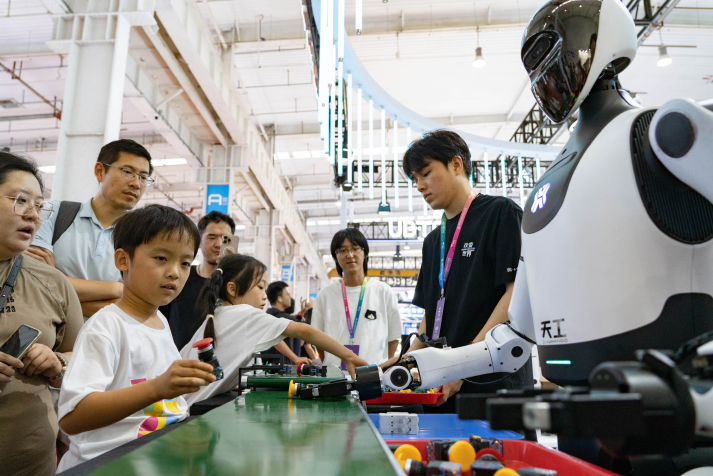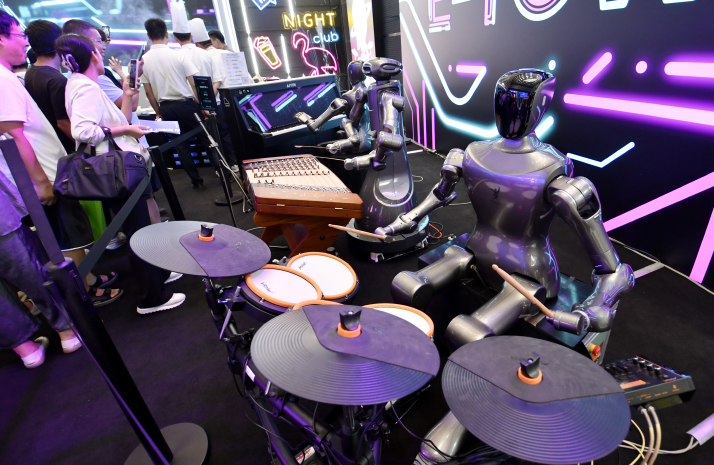| China |
| Robotics exhibition brings science fiction into reality | |
|
|
 Visitors gather to watch the humanoid robot Tiangong in action during the 2025 World Robot Conference in Beijing on August 11 (XINHUA)
Buying a robot at the venue of the 2025 World Robot Conference (WRC) is as easy as buying a car. During the conference, held in Beijing on August 8-12, a major highlight was the opening of the world's first embodied AI robot 4S store on August 8. The store allows consumers to test-drive robots just like they would with cars.
The showcased robots span seven major categories, including medical, industrial and companionship, with prices ranging from affordable models at just a few hundred yuan (around $100) to high-end professional units priced in the millions. Visitors here can also interact with robotic dogs, robotic arms, racing robots, basketball-shooting robots, and other humanoid models. During the conference, the store drew massive crowds, with long queues forming daily, making it one of the event's most popular attractions. "Bringing my child here was eye-opening," a Beijing resident surnamed Tang told newspaper People's Daily. "Humanoid robots used to seem like something from the distant future, but now they're clearly part of our daily lives."  A robot band performs at the 2025 World Robot Conference in Beijing on August 8 (XINHUA)
From sci-fi to showroom Themed Making Robots Smarter, Making Embodied Agents More Intelligent, the five-day WRC featured forums, exhibitions, competitions and networking activities. More than 200 global exhibitors, including over 50 humanoid robot manufacturers, presented a total of 1,500 plus products including many complete humanoid robot sets, some of which are global premieres. Humanoid robots unequivocally claimed center stage. Next to the 4S store, an interactive robot kitchen exhibit became a viral sensation, featuring skewer-bots that maintained perfect grill temperatures, pancake robots serving meals in three minutes, drink-mixing automatons handling sterilization, chilling and cap removal, and barista bots creating professional-grade latte art. The space hummed with autonomous trash-collecting and cleaning robots, while a robot band, equipped with AI superbrain, stole the show by composing original music in real-time and choreographing dance routines within 30 minutes. A highlight was the exhibition zone of Unitree Robotics, a robotics company based in Hangzhou, Zhejiang Province. The company staged a humanoid robot fighting tournament. Two robots, powered by proprietary algorithms, threw precise uppercuts and hooks, drawing roaring applause from spectators. "With policy tailwinds, the robotics sector saw exceptional growth in the first half of this year," Unitree founder Wang Xingxing revealed in a speech at the WRC. Figures from WRC show that China's robotics industry achieved 27.8 percent revenue growth in the first six months of this year, with industrial and service robot production maintaining rapid expansion, marking the country's 12th consecutive year as the world's largest industrial robot market. Opposite Unitree's booth, Beijing-based Booster Robotics innovatively designed their exhibition space as a mini soccer field, hosting not only robot demonstration matches but also human-robot interaction sessions, where robots took penalty kicks while children played as goalkeepers. This novel interactive format attracted large crowds of spectators. The Beijing Humanoid Robot Innovation Center's flagship Tien Kung series continues to lead trends. Following its Tien Kung Ultra model's championship victory at the world's first humanoid robot half-marathon, held in Beijing on April 13, its upgraded Tien Kung 2.0 made a grand appearance at this year's WRC. By giving demonstrations of its multi-robot, multi-task collaborative capabilities, the Tien Kung 2.0 gave spectators a show of its transformation from "marathon champion" to "industrial all-rounder." Other robots made equally noteworthy demonstrations of their practical value in specific scenarios. Magic Clap, a robotic company from Suzhou, Jiangsu Province, displayed its flagship product—the industrial-grade quadruped robot MagicDog Y1. Developed based on deep market insight, this product is specifically designed for extreme industrial environments, featuring aerospace-grade sealed construction that maintains stable operation within a broad temperature range from -20 to 55 degrees Celsius, making it particularly suitable for critical scenarios like industrial inspection and emergency rescue. Lexiang Technology's W-bot, nicknamed WAWA, became a show highlight with its adorable appearance. This consumer-grade tracked robot for outdoor family scenarios integrates multiple functions: load capacity of 20-30 kg for towing camping gear, built-in high-quality audio system supporting music playback and karaoke, large-capacity battery serving as mobile power supply for small appliances, and smart-follow camera that both captures outdoor moments and provides security monitoring. The product has announced a presale price of 35,999 yuan ($5,000). From factory to family The homecare and elderly assistance sector also featured several noteworthy robotic exhibits at this WRC. Beijing Galbot Co. Ltd. showcased its embodied AI robot Galbot, demonstrating exceptional household capabilities—precisely delivering water glasses, quickly cleaning floor debris, safely handling broken glass, and assisting with laundry hanging. Guangzhou Automobile Group presented its second-generation embodied AI robots GoMove and GoSide, specifically designed for senior care. GoMove functions as a wheel-legged passenger robot that smoothly assists seated elders with stair navigation, while GoSide serves as an intelligent butler, maneuvering flexibly through indoor spaces to promptly respond to and accurately execute various commands. The robot enables remote companionship through visual sharing technology and boasts over four hours of continuous operation for sustained performance. Despite significant growth in the robotics industry, the WRC also revealed some development challenges. Exhibition attendees occasionally witnessed operational flaws: Some robots tumbled due to errors, others moved sluggishly during tasks with poor efficiency, and several had to pause for recharging after just three hours of continuous demonstration. During the main forum at the WRC, industry leaders shared perspectives on embodied AI robotics development. "While embodied AI robots attract attention, there remains considerable distance to truly versatile humanoid robots," said Takayuki Ito, President of the International Federation of Robotics. Unitree founder Wang revealed a common misconception about robotic systems: People often blame limited applications of humanoid robots on hardware deficiencies or high costs, whereas the real bottleneck lies in the immature embodied AI technology. "Current robotic large language models remain underdeveloped," he said. (Print Edition Title: The Robot Bonanza) Copyedited by G.P. Wilson Comments to yuanyuan@cicgamericas.com |
|
||||||||||||||||||||||||||||||
|